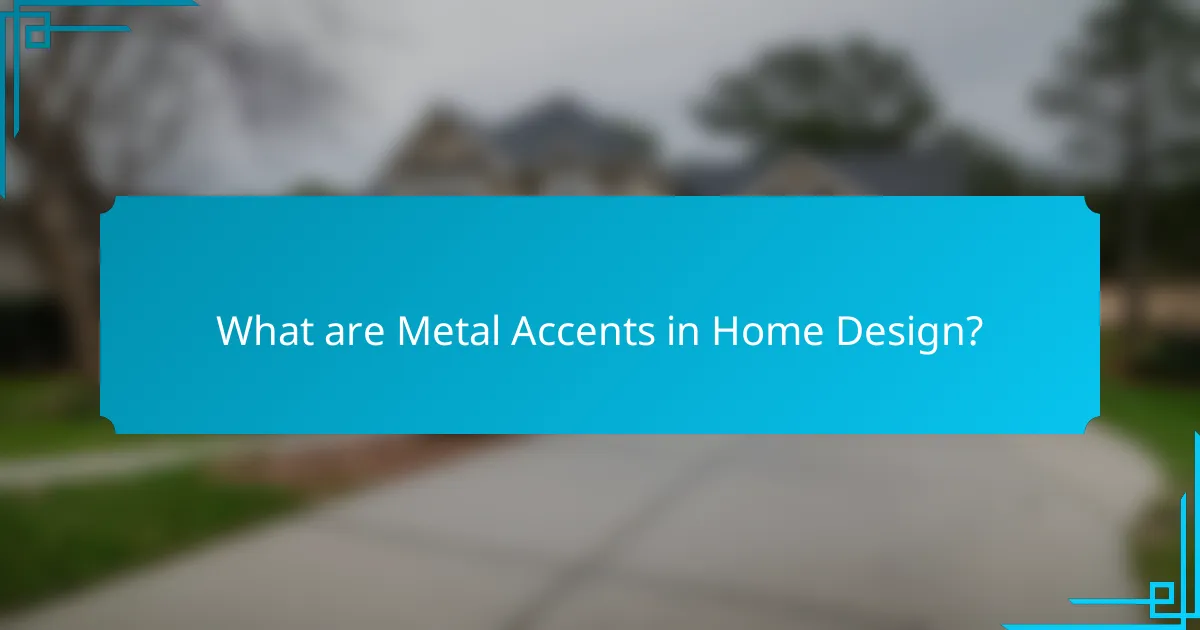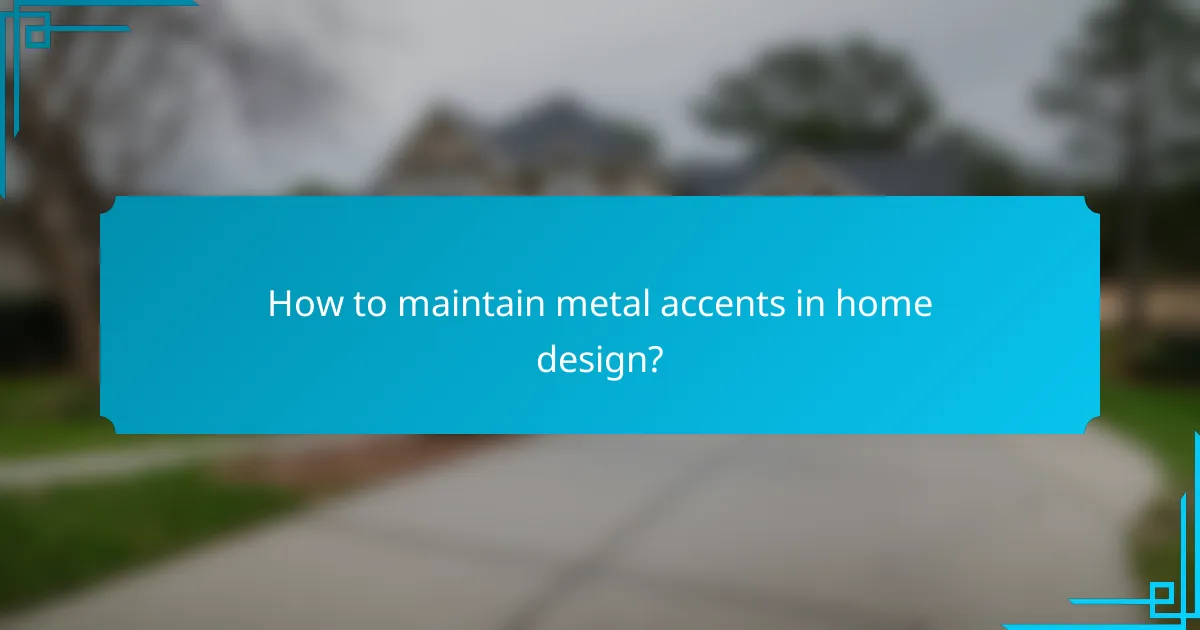Metal accents are decorative elements in home design made from various metals, enhancing spaces with visual interest and texture. Common metals include brass, copper, and stainless steel, which can be incorporated into light fixtures, hardware, and furniture. The article explores different finishes available for metal accents, such as brushed, polished, matte, and antiqued, each contributing uniquely to the overall design. Additionally, it provides maintenance practices to preserve the appearance and longevity of these accents, emphasizing the importance of regular cleaning and appropriate care for different metal types. The growing popularity of metal accents in contemporary interior design reflects their versatility and ability to complement both modern and traditional styles.

What are Metal Accents in Home Design?
Metal accents in home design are decorative elements made from various metals. They include features like light fixtures, hardware, and furniture. These accents add visual interest and texture to spaces. Common metals used are brass, copper, and stainless steel. Metal accents can enhance both modern and traditional styles. They reflect light, creating a sense of brightness in a room. The use of metal accents has become increasingly popular in contemporary interior design. Their versatility allows for creative combinations with other materials.
How do metal accents enhance home design aesthetics?
Metal accents enhance home design aesthetics by adding visual interest and sophistication. They create a contrast with other materials, such as wood or fabric. This contrast can elevate the overall design by introducing texture and shine. Metal accents also reflect light, which can make spaces appear brighter and more open. Popular finishes like brass, copper, and stainless steel each bring unique character to a room. Incorporating metal elements can also tie together different design styles, creating cohesion. Research shows that homes with mixed materials, including metal, have higher perceived value. Therefore, metal accents are an effective way to enhance the aesthetic appeal of home interiors.
What types of metal accents are commonly used in interior design?
Common types of metal accents in interior design include brass, copper, stainless steel, and wrought iron. Brass accents often add warmth and elegance to spaces. Copper is known for its distinctive reddish hue and can create a rustic feel. Stainless steel is valued for its modern, sleek appearance and durability. Wrought iron is frequently used for its strength and intricate designs. These metals can be found in fixtures, furniture, and decorative elements throughout various interior styles.
How do metal accents complement different design styles?
Metal accents enhance various design styles by adding texture and visual interest. In modern designs, sleek metal finishes create a minimalist aesthetic. Industrial styles benefit from raw, unfinished metal elements that emphasize ruggedness. Traditional designs incorporate polished metals to evoke elegance and sophistication. Rustic styles use aged metals to complement natural materials like wood. Each design style integrates metal accents uniquely, enhancing its overall theme. For example, the use of brass in mid-century modern design highlights warmth and nostalgia. Studies show that incorporating metal accents can improve the perceived value of a space.
Why choose metal accents for home design?
Metal accents enhance home design by adding visual interest and texture. They provide a modern and sophisticated look. Various metals, like brass, copper, and stainless steel, can complement different styles. Metal accents are durable and long-lasting, making them a practical choice. They can be used in lighting fixtures, furniture, and decorative elements. Incorporating metal can also create a sense of balance in a room. According to a study by the American Society of Interior Designers, 70% of designers recommend using metal accents for contemporary spaces. This trend reflects the growing popularity of mixed materials in interior design.
What benefits do metal accents provide in terms of durability?
Metal accents enhance durability in home design by providing resistance to wear and tear. They are less prone to damage compared to materials like wood or plastic. Metal does not warp, crack, or fade over time. This stability ensures that metal accents maintain their aesthetic appeal. Additionally, metals like stainless steel and aluminum are resistant to rust and corrosion. This quality extends their lifespan in various environments. The durability of metal accents contributes to lower replacement costs. Overall, metal accents are a long-lasting choice for enhancing both function and style in home design.
How do metal accents contribute to the overall ambiance of a space?
Metal accents enhance the overall ambiance of a space by adding texture and visual interest. They create a sense of modernity and sophistication. Various metal finishes, such as brushed nickel or polished brass, can evoke different feelings. For instance, warm metals like copper create a cozy atmosphere. Cool metals like stainless steel contribute to a sleek, contemporary vibe. Metal accents also reflect light, which can make a space feel larger and more open. The strategic placement of these accents can draw attention to architectural features. Overall, metal accents serve as focal points that elevate the design of a room.
What are the different styles of metal accents available?
The different styles of metal accents available include industrial, modern, rustic, and vintage. Industrial metal accents often feature raw finishes and exposed elements. Modern styles focus on sleek lines and polished surfaces. Rustic metal accents highlight patinas and weathered looks. Vintage styles incorporate ornate designs and antique finishes. Each style caters to various design aesthetics and preferences.
How does industrial style incorporate metal accents?
Industrial style incorporates metal accents through the use of raw materials and utilitarian design. This design aesthetic often features exposed metal beams, pipes, and fixtures. Metal accents can be found in furniture, such as steel tables and iron chairs. Lighting fixtures in industrial spaces frequently utilize metal shades and frames. The color palette typically includes metallic tones like silver, bronze, and black. These elements contribute to a rugged, unfinished look that defines the industrial style. The incorporation of metal accents also emphasizes functionality and durability. Overall, metal accents are essential to creating an authentic industrial atmosphere.
What role do metal accents play in modern and minimalist designs?
Metal accents enhance modern and minimalist designs by adding visual interest and sophistication. They serve as focal points that contrast with softer materials. Common metal finishes include brass, copper, and stainless steel. These finishes can create a sense of balance and harmony in a space. Metal accents also contribute to the overall aesthetic by reflecting light, which can make a room feel more open. Their sleek appearance aligns with the minimalist ethos of simplicity and functionality. Studies show that incorporating metal elements can elevate the perceived value of a space. This interplay of materials is essential in achieving a cohesive design.

What finishes are available for metal accents?
Common finishes available for metal accents include brushed, polished, matte, and antiqued. Brushed finishes provide a subtle texture and reduce visibility of fingerprints. Polished finishes create a shiny, reflective surface that enhances light reflection. Matte finishes offer a non-reflective appearance, ideal for a modern aesthetic. Antiqued finishes give a vintage look, often featuring a patina effect. These finishes are used in various applications, such as hardware, fixtures, and decorative elements. Each finish can significantly influence the overall design and feel of a space.
How do different finishes affect the appearance of metal accents?
Different finishes significantly alter the appearance of metal accents. A polished finish creates a reflective surface, enhancing shine and brightness. This type of finish often highlights details and textures in the metal. In contrast, a matte finish offers a softer, non-reflective look. It can create a more understated and modern aesthetic.
Brushed finishes add a textured pattern, diffusing light and reducing glare. This can enhance the visual interest without overwhelming other design elements. An antiqued finish gives a vintage look, adding depth and character to the metal. It can evoke a sense of history and warmth in a space.
Additionally, coatings like powder coating can introduce color while providing durability. These finishes can dramatically change the overall style and feel of metal accents in a room. The choice of finish should align with the desired aesthetic and functional requirements.
What are the most popular finishes for metal accents in home design?
The most popular finishes for metal accents in home design include brushed nickel, oil-rubbed bronze, and polished chrome. Brushed nickel offers a soft, muted appearance and is resistant to fingerprints. Oil-rubbed bronze provides a rich, dark finish with a vintage look. Polished chrome is known for its shiny, reflective surface that enhances modern aesthetics. Other finishes like matte black and antique brass have also gained popularity. These finishes are chosen for their durability and ability to complement various design styles.
How do finishes impact the maintenance of metal accents?
Finishes significantly impact the maintenance of metal accents. Different finishes offer varying levels of protection against corrosion and wear. For instance, a powder-coated finish provides a durable layer that resists scratches and fading. This reduces the frequency of cleaning and maintenance required. Conversely, polished metal finishes may require more regular upkeep to prevent tarnishing. The finish type also influences how easily dirt and grime accumulate. Textured finishes can hide fingerprints better than smooth ones. Understanding these factors helps in selecting finishes that align with desired maintenance levels.
Why is the choice of finish important in home design?
The choice of finish is important in home design because it affects aesthetics, durability, and maintenance. Finishes can enhance the visual appeal of metal accents, influencing the overall style of a space. Different finishes, such as matte or glossy, create distinct looks that can complement various design themes. Additionally, the finish impacts the longevity of materials. For instance, a protective coating can prevent corrosion and wear. This choice also dictates the level of upkeep required. Some finishes may require more frequent cleaning or refinishing. Thus, selecting the right finish is crucial for achieving desired design outcomes while ensuring practicality.
How does the finish influence the longevity of metal accents?
The finish of metal accents significantly influences their longevity. A protective finish, such as powder coating or plating, prevents corrosion and tarnishing. This barrier shields the metal from moisture and environmental factors. For example, stainless steel finishes resist rust and extend lifespan. Conversely, uncoated metals are more susceptible to wear and damage. Regular maintenance also affects longevity. Proper cleaning and reapplication of finishes can enhance durability. Therefore, the choice and quality of the finish are crucial for maximizing the lifespan of metal accents.
What finishes are best suited for specific environments?
Finishes best suited for specific environments include stainless steel for kitchens and bathrooms. Stainless steel resists corrosion and is easy to clean. For outdoor areas, weather-resistant finishes like powder coating are ideal. Powder coating protects metal from UV rays and moisture. In high-humidity environments, consider using galvanized finishes. Galvanized metal has a protective zinc coating that prevents rust. For industrial settings, epoxy finishes provide durability and chemical resistance. Epoxy coatings withstand harsh conditions and are easy to maintain. Each finish is chosen based on its ability to withstand environmental factors.

How to maintain metal accents in home design?
To maintain metal accents in home design, regularly clean them to prevent tarnishing. Use a soft cloth and a gentle cleaner suitable for the metal type. For stainless steel, a mixture of vinegar and water works effectively. Copper and brass may require specific polishes to restore shine. Avoid abrasive materials that can scratch the surface. Inspect for rust or corrosion and treat immediately with appropriate solutions. Applying a protective sealant can help preserve the finish. Regular maintenance extends the life and aesthetic appeal of metal accents.
What are the best practices for cleaning metal accents?
The best practices for cleaning metal accents include using a soft cloth and mild soap solution. Start by dusting the metal surface to remove loose debris. Next, mix warm water with a few drops of dish soap. Dampen the cloth in the solution and gently wipe the metal accents. Avoid abrasive materials that can scratch the surface. For tarnished metal, use a specialized metal polish according to the manufacturer’s instructions. Rinse with clean water and dry thoroughly to prevent water spots. Regular cleaning helps maintain the appearance and longevity of metal accents.
How often should metal accents be maintained for optimal appearance?
Metal accents should be maintained every 3 to 6 months for optimal appearance. Regular maintenance prevents tarnishing and corrosion. Cleaning metal accents can involve using a soft cloth and appropriate cleaner. For outdoor metal accents, more frequent maintenance may be necessary due to exposure to the elements. Regular checks help identify any signs of wear or damage early. This practice ensures the longevity and aesthetic appeal of the metal features. Proper maintenance directly impacts the overall look of the home design.
What cleaning products are safe for different metal finishes?
For different metal finishes, safe cleaning products include mild dish soap, white vinegar, and baking soda. Mild dish soap diluted in water is safe for most metals. White vinegar effectively cleans tarnished brass and copper without damage. Baking soda is gentle and can be used for polishing stainless steel. Avoid acidic cleaners on aluminum, as they can cause corrosion. For chrome finishes, use a non-abrasive cleaner to maintain shine. Always test any cleaner on a small, inconspicuous area first.
What common issues arise with metal accents and how to troubleshoot them?
Common issues with metal accents include tarnishing, scratching, and corrosion. Tarnishing occurs due to oxidation. Regular cleaning with appropriate solutions can prevent this. Scratching can happen from heavy contact or abrasive cleaners. Use soft cloths and gentle cleaners to avoid damage. Corrosion may arise from exposure to moisture or harsh chemicals. Applying protective coatings can mitigate this risk. Regular maintenance is essential for preserving the appearance and longevity of metal accents.
How can rust or tarnish be prevented on metal accents?
To prevent rust or tarnish on metal accents, apply a protective coating. This can include paint, lacquer, or clear sealant. These coatings create a barrier against moisture and air. Regular cleaning with a soft cloth also helps. Avoid abrasive materials that can scratch the surface. Store metal accents in a dry environment to minimize exposure to humidity. Use silica gel packets in storage areas to absorb moisture. These methods are effective in prolonging the life of metal accents.
What steps should be taken if metal accents become damaged?
Assess the damage to the metal accents first. Determine if the damage is superficial or structural. For minor scratches, use a metal polish or cleaner to restore shine. Apply the polish with a soft cloth and buff gently. For more significant dents or scratches, consider using a filler or touch-up paint designed for metal surfaces. If the damage is extensive, consult a professional for repair or replacement. Regular maintenance can prevent future damage. Cleaning metal accents with appropriate products helps maintain their appearance and durability.
What tips can enhance the use of metal accents in home design?
Incorporating metal accents in home design can be enhanced by selecting the right finish. Matte finishes reduce glare and create a subtle elegance. Polished metals, such as chrome or brass, add a modern and reflective quality. Combining different metal types can create visual interest. For instance, mixing gold and silver can add depth to a space. Use metal accents strategically to highlight architectural features or focal points. Placing metal fixtures near natural light enhances their brilliance. Balance metal accents with softer materials like wood or textiles to avoid a cold feel. Finally, consider the scale of metal pieces to ensure they complement the surrounding decor.
Metal accents are decorative elements in home design crafted from various metals, such as brass, copper, and stainless steel, which enhance both modern and traditional aesthetics. This article explores how metal accents add visual interest, texture, and durability to spaces, detailing their common types, styles, and finishes. It also addresses maintenance practices to preserve their appearance and longevity, while highlighting the benefits of incorporating metal accents in different design contexts. Additionally, the article examines the impact of finishes on aesthetics and upkeep, providing practical tips for selecting and maintaining metal accents in home interiors.